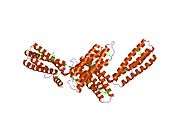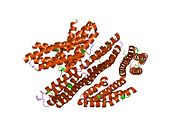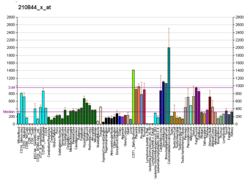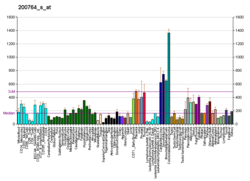Catenin alpha-1
| CTNNA1 | |||||||||||||||||||||||||||||||||||||||||||||||||||
|---|---|---|---|---|---|---|---|---|---|---|---|---|---|---|---|---|---|---|---|---|---|---|---|---|---|---|---|---|---|---|---|---|---|---|---|---|---|---|---|---|---|---|---|---|---|---|---|---|---|---|---|
 | |||||||||||||||||||||||||||||||||||||||||||||||||||
| |||||||||||||||||||||||||||||||||||||||||||||||||||
| Identifiers | |||||||||||||||||||||||||||||||||||||||||||||||||||
| Aliases | CTNNA1, CAP102, Catenin, MDPT2, catenin alpha 1 | ||||||||||||||||||||||||||||||||||||||||||||||||||
| External IDs | OMIM: 116805; MGI: 88274; HomoloGene: 1433; GeneCards: CTNNA1; OMA:CTNNA1 - orthologs | ||||||||||||||||||||||||||||||||||||||||||||||||||
| |||||||||||||||||||||||||||||||||||||||||||||||||||
| |||||||||||||||||||||||||||||||||||||||||||||||||||
| |||||||||||||||||||||||||||||||||||||||||||||||||||
| |||||||||||||||||||||||||||||||||||||||||||||||||||
| |||||||||||||||||||||||||||||||||||||||||||||||||||
| Wikidata | |||||||||||||||||||||||||||||||||||||||||||||||||||
| |||||||||||||||||||||||||||||||||||||||||||||||||||
αE-catenin, also known as Catenin alpha-1 is a protein that in humans is encoded by the CTNNA1 gene.[5][6] αE-catenin is highly expressed in cardiac muscle and localizes to adherens junctions at intercalated disc structures where it functions to mediate the anchorage of actin filaments to the sarcolemma. αE-catenin also plays a role in tumor metastasis and skin cell function.
Structure
Human αE-catenin protein is 100.0 kDa and 906 amino acids.[7] Catenins (α,β,and γ (also known as plakoglobin)) were originally identified in complex with E-cadherin, an epithelial cell adhesion protein. αE-catenin is highly expressed in cardiac muscle[8][9] and is homologous to the protein vinculin; however, aside from vinculin, αE-catenin has no homology to established actin-binding proteins. The N-terminus of αE-catenin binds β-catenin or γ-catenin/plakoglobin, and the C-terminus binds actin directly or indirectly via vinculin or α-actinin.[10]
Function
Though αE-catenin exhibits substantial expression in cardiac muscle, αE-catenin is most well known for role in metastasizing tumor cells.[11] αE-catenin also plays a role in epithelial tissue, both at adherens junctions and in signaling pathways.[12]
In cardiomyocytes, αE-catenin is present in cell to cell regions known as adherens junctions which lie within intercalated discs; these junctions anchor the actin cytoskeleton to the sarcolemma and provide strong cell adhesion.[13]
Functional αE-catenin is required for normal embryonic development, as a mutation eliminating the C-terminal 1/3 of the protein resulting in a complete loss-of-function phenotype showed disruption of the trophoblast epithelium and arrested development at the blastocyst stage.[14]
αE-catenin specifically, not β- or γ-catenin, binds F-actin and organizes and tethers the filaments at regions of cell-cell contact. Studies show that full-length αE-catenin binds and bundles F-actin in a superior fashion relative to individual N-terminal or C-terminal domains.[15]
αE-catenin, along with β-catenin and plakoglobin form distinct complexes with N-cadherin that are involved in forming cell-cell contacts and differentiation of cardiomyocytes. Catenin-N-cadherin complexes are apparently necessary for and precede the first cell to cell contact, precursory to gap junction formation.[16] The anchorage of cadherin-catenin complexes to actin filaments by αE-catenin is regulated by tyrosine phosphorylation.[17]
Functional insights into αE-catenin function have come from studies employing transgenesis. Mice harboring a cardiac-specific deletion of αE-catenin exhibited abnormalities in cardiac dimensions and function, representative of dilated cardiomyopathy. This was further characterized by disorganization of intercalated disc structures and mitochondria, as well as compensatory increases in β-catenin and decreases in localization of cadherin and vinculin at intercalated discs. Knockout mice also exhibited high susceptibility to death following stress.[18]
Clinical significance
Interactions
αE-catenin has been shown to interact with:
See also
References
- ^ a b c GRCh38: Ensembl release 89: ENSG00000044115 – Ensembl, May 2017
- ^ a b c GRCm38: Ensembl release 89: ENSMUSG00000037815 – Ensembl, May 2017
- ^ "Human PubMed Reference:". National Center for Biotechnology Information, U.S. National Library of Medicine.
- ^ "Mouse PubMed Reference:". National Center for Biotechnology Information, U.S. National Library of Medicine.
- ^ Herrenknecht K, Ozawa M, Eckerskorn C, Lottspeich F, Lenter M, Kemler R (November 1991). "The uvomorulin-anchorage protein alpha-catenin is a vinculin homologue". Proc Natl Acad Sci U S A. 88 (20): 9156–60. Bibcode:1991PNAS...88.9156H. doi:10.1073/pnas.88.20.9156. PMC 52671. PMID 1924379.
- ^ "Entrez Gene: CTNNA1 catenin (cadherin-associated protein), alpha 1, 102kDa".
- ^ "Protein sequence of human CTNNA1 (Uniprot ID: P35221)". Cardiac Organellar Protein Atlas Knolwedgebase (COPaKB). Archived from the original on 4 July 2015. Retrieved 3 July 2015.
- ^ Janssens B, Goossens S, Staes K, Gilbert B, van Hengel J, Colpaert C, Bruyneel E, Mareel M, van Roy F (Sep 2001). "alphaT-catenin: a novel tissue-specific beta-catenin-binding protein mediating strong cell-cell adhesion". Journal of Cell Science. 114 (Pt 17): 3177–88. doi:10.1242/jcs.114.17.3177. PMID 11590244.
- ^ Ehler E, Horowits R, Zuppinger C, Price RL, Perriard E, Leu M, Caroni P, Sussman M, Eppenberger HM, Perriard JC (May 2001). "Alterations at the intercalated disk associated with the absence of muscle LIM protein". The Journal of Cell Biology. 153 (4): 763–72. doi:10.1083/jcb.153.4.763. PMC 2192386. PMID 11352937.
- ^ Drees F, Pokutta S, Yamada S, Nelson WJ, Weis WI (Dec 2005). "Alpha-catenin is a molecular switch that binds E-cadherin-beta-catenin and regulates actin-filament assembly". Cell. 123 (5): 903–15. doi:10.1016/j.cell.2005.09.021. PMC 3369825. PMID 16325583.
- ^ Breen E, Clarke A, Steele G, Mercurio AM (Dec 1993). "Poorly differentiated colon carcinoma cell lines deficient in alpha-catenin expression express high levels of surface E-cadherin but lack Ca(2+)-dependent cell-cell adhesion". Cell Adhesion and Communication. 1 (3): 239–50. doi:10.3109/15419069309097257. PMID 8081881.
- ^ Vasioukhin V, Bauer C, Degenstein L, Wise B, Fuchs E (Feb 2001). "Hyperproliferation and defects in epithelial polarity upon conditional ablation of alpha-catenin in skin". Cell. 104 (4): 605–17. doi:10.1016/s0092-8674(01)00246-x. PMID 11239416. S2CID 6029663.
- ^ Jamora C, Fuchs E (Apr 2002). "Intercellular adhesion, signalling and the cytoskeleton". Nature Cell Biology. 4 (4): E101–8. doi:10.1038/ncb0402-e101. PMID 11944044. S2CID 22314929.
- ^ Torres M, Stoykova A, Huber O, Chowdhury K, Bonaldo P, Mansouri A, Butz S, Kemler R, Gruss P (Feb 1997). "An alpha-E-catenin gene trap mutation defines its function in preimplantation development". Proceedings of the National Academy of Sciences of the United States of America. 94 (3): 901–6. Bibcode:1997PNAS...94..901T. doi:10.1073/pnas.94.3.901. PMC 19611. PMID 9023354.
- ^ Rimm DL, Koslov ER, Kebriaei P, Cianci CD, Morrow JS (Sep 1995). "Alpha 1(E)-catenin is an actin-binding and -bundling protein mediating the attachment of F-actin to the membrane adhesion complex". Proceedings of the National Academy of Sciences of the United States of America. 92 (19): 8813–7. Bibcode:1995PNAS...92.8813R. doi:10.1073/pnas.92.19.8813. PMC 41057. PMID 7568023.
- ^ Hertig CM, Butz S, Koch S, Eppenberger-Eberhardt M, Kemler R, Eppenberger HM (Jan 1996). "N-cadherin in adult rat cardiomyocytes in culture. II. Spatio-temporal appearance of proteins involved in cell-cell contact and communication. Formation of two distinct N-cadherin/catenin complexes". Journal of Cell Science. 109 (1): 11–20. doi:10.1242/jcs.109.1.11. PMID 8834786.
- ^ Aberle H, Schwartz H, Kemler R (Jun 1996). "Cadherin-catenin complex: protein interactions and their implications for cadherin function". Journal of Cellular Biochemistry. 61 (4): 514–23. doi:10.1002/(SICI)1097-4644(19960616)61:4<514::AID-JCB4>3.0.CO;2-R. PMID 8806074. S2CID 24566745.
- ^ Sheikh F, Chen Y, Chen Y, Liang X, Hirschy A, Stenbit AE, Gu Y, Dalton ND, Yajima T, Lu Y, Knowlton KU, Peterson KL, Perriard JC, Chen J (Sep 2006). "alpha-E-catenin inactivation disrupts the cardiomyocyte adherens junction, resulting in cardiomyopathy and susceptibility to wall rupture". Circulation. 114 (10): 1046–55. doi:10.1161/CIRCULATIONAHA.106.634469. PMID 16923756.
- ^ Su LK, Vogelstein B, Kinzler KW (December 1993). "Association of the APC tumor suppressor protein with catenins". Science. 262 (5140): 1734–7. Bibcode:1993Sci...262.1734S. doi:10.1126/science.8259519. PMID 8259519.
- ^ Daniel JM, Reynolds AB (September 1995). "The tyrosine kinase substrate p120cas binds directly to E-cadherin but not to the adenomatous polyposis coli protein or alpha-catenin". Mol. Cell. Biol. 15 (9): 4819–24. doi:10.1128/mcb.15.9.4819. PMC 230726. PMID 7651399.
- ^ Oyama T, Kanai Y, Ochiai A, Akimoto S, Oda T, Yanagihara K, Nagafuchi A, Tsukita S, Shibamoto S, Ito F (December 1994). "A truncated beta-catenin disrupts the interaction between E-cadherin and alpha-catenin: a cause of loss of intercellular adhesiveness in human cancer cell lines". Cancer Res. 54 (23): 6282–7. PMID 7954478.
- ^ a b Roe S, Koslov ER, Rimm DL (June 1998). "A mutation in alpha-catenin disrupts adhesion in clone A cells without perturbing its actin and beta-catenin binding activity". Cell Adhes. Commun. 5 (4): 283–96. doi:10.3109/15419069809040298. PMID 9762469.
- ^ Piedra J, Miravet S, Castaño J, Pálmer HG, Heisterkamp N, García de Herreros A, Duñach M (April 2003). "p120 Catenin-associated Fer and Fyn tyrosine kinases regulate beta-catenin Tyr-142 phosphorylation and beta-catenin-alpha-catenin Interaction". Mol. Cell. Biol. 23 (7): 2287–97. doi:10.1128/mcb.23.7.2287-2297.2003. PMC 150740. PMID 12640114.
- ^ Aberle H, Butz S, Stappert J, Weissig H, Kemler R, Hoschuetzky H (December 1994). "Assembly of the cadherin-catenin complex in vitro with recombinant proteins". J. Cell Sci. 107 (12): 3655–63. doi:10.1242/jcs.107.12.3655. PMID 7706414.
- ^ Reuver SM, Garner CC (April 1998). "E-cadherin mediated cell adhesion recruits SAP97 into the cortical cytoskeleton". J. Cell Sci. 111 (8): 1071–80. doi:10.1242/jcs.111.8.1071. PMID 9512503.
- ^ Kinch MS, Clark GJ, Der CJ, Burridge K (July 1995). "Tyrosine phosphorylation regulates the adhesions of ras-transformed breast epithelia". J. Cell Biol. 130 (2): 461–71. doi:10.1083/jcb.130.2.461. PMC 2199929. PMID 7542250.
- ^ Oneyama C, Nakano H, Sharma SV (March 2002). "UCS15A, a novel small molecule, SH3 domain-mediated protein-protein interaction blocking drug". Oncogene. 21 (13): 2037–50. doi:10.1038/sj.onc.1205271. PMID 11960376.
- ^ Navarro P, Lozano E, Cano A (August 1993). "Expression of E- or P-cadherin is not sufficient to modify the morphology and the tumorigenic behavior of murine spindle carcinoma cells. Possible involvement of plakoglobin". J. Cell Sci. 105 (4): 923–34. doi:10.1242/jcs.105.4.923. hdl:10261/78716. PMID 8227214.
- ^ Takahashi K, Suzuki K, Tsukatani Y (July 1997). "Induction of tyrosine phosphorylation and association of beta-catenin with EGF receptor upon tryptic digestion of quiescent cells at confluence". Oncogene. 15 (1): 71–8. doi:10.1038/sj.onc.1201160. PMID 9233779.
- ^ a b Schmeiser K, Grand RJ (April 1999). "The fate of E- and P-cadherin during the early stages of apoptosis". Cell Death Differ. 6 (4): 377–86. doi:10.1038/sj.cdd.4400504. PMID 10381631.
- ^ Straub BK, Boda J, Kuhn C, Schnoelzer M, Korf U, Kempf T, Spring H, Hatzfeld M, Franke WW (December 2003). "A novel cell-cell junction system: the cortex adhaerens mosaic of lens fiber cells". J. Cell Sci. 116 (Pt 24): 4985–95. doi:10.1242/jcs.00815. PMID 14625392.
- ^ Wahl JK, Kim YJ, Cullen JM, Johnson KR, Wheelock MJ (May 2003). "N-cadherin-catenin complexes form prior to cleavage of the proregion and transport to the plasma membrane". J. Biol. Chem. 278 (19): 17269–76. doi:10.1074/jbc.M211452200. PMID 12604612.
- ^ Klingelhöfer J, Troyanovsky RB, Laur OY, Troyanovsky S (August 2000). "Amino-terminal domain of classic cadherins determines the specificity of the adhesive interactions". J. Cell Sci. 113 (16): 2829–36. doi:10.1242/jcs.113.16.2829. PMID 10910767.
- ^ Sacco PA, McGranahan TM, Wheelock MJ, Johnson KR (August 1995). "Identification of plakoglobin domains required for association with N-cadherin and alpha-catenin". J. Biol. Chem. 270 (34): 20201–6. doi:10.1074/jbc.270.34.20201. PMID 7650039.
- ^ Obama H, Ozawa M (April 1997). "Identification of the domain of alpha-catenin involved in its association with beta-catenin and plakoglobin (gamma-catenin)". J. Biol. Chem. 272 (17): 11017–20. doi:10.1074/jbc.272.17.11017. PMID 9110993.
- ^ Lewalle JM, Bajou K, Desreux J, Mareel M, Dejana E, Noël A, Foidart JM (December 1997). "Alteration of interendothelial adherens junctions following tumor cell-endothelial cell interaction in vitro". Exp. Cell Res. 237 (2): 347–56. doi:10.1006/excr.1997.3799. hdl:2268/61990. PMID 9434630.
- ^ Shasby DM, Ries DR, Shasby SS, Winter MC (June 2002). "Histamine stimulates phosphorylation of adherens junction proteins and alters their link to vimentin". Am. J. Physiol. Lung Cell Mol. Physiol. 282 (6): L1330–8. CiteSeerX 10.1.1.1000.5266. doi:10.1152/ajplung.00329.2001. PMID 12003790.
Further reading
- Nagafuchi A, Takeichi M, Tsukita S (1991). "The 102 kd cadherin-associated protein: similarity to vinculin and posttranscriptional regulation of expression". Cell. 65 (5): 849–57. doi:10.1016/0092-8674(91)90392-C. PMID 1904011. S2CID 38622586.
- Kinch MS, Clark GJ, Der CJ, Burridge K (1995). "Tyrosine phosphorylation regulates the adhesions of ras-transformed breast epithelia". J. Cell Biol. 130 (2): 461–71. doi:10.1083/jcb.130.2.461. PMC 2199929. PMID 7542250.
- Sacco PA, McGranahan TM, Wheelock MJ, Johnson KR (1995). "Identification of plakoglobin domains required for association with N-cadherin and alpha-catenin". J. Biol. Chem. 270 (34): 20201–6. doi:10.1074/jbc.270.34.20201. PMID 7650039.
- Daniel JM, Reynolds AB (1995). "The tyrosine kinase substrate p120cas binds directly to E-cadherin but not to the adenomatous polyposis coli protein or alpha-catenin". Mol. Cell. Biol. 15 (9): 4819–24. doi:10.1128/mcb.15.9.4819. PMC 230726. PMID 7651399.
- Aberle H, Butz S, Stappert J, Weissig H, Kemler R, Hoschuetzky H (1995). "Assembly of the cadherin-catenin complex in vitro with recombinant proteins". J. Cell Sci. 107 (12): 3655–63. doi:10.1242/jcs.107.12.3655. PMID 7706414.
- Knudsen KA, Soler AP, Johnson KR, Wheelock MJ (1995). "Interaction of alpha-actinin with the cadherin/catenin cell-cell adhesion complex via alpha-catenin". J. Cell Biol. 130 (1): 67–77. doi:10.1083/jcb.130.1.67. PMC 2120515. PMID 7790378.
- Rimm DL, Kebriaei P, Morrow JS (1994). "Molecular cloning reveals alternative splice forms of human alpha(E)-catenin". Biochem. Biophys. Res. Commun. 203 (3): 1691–9. doi:10.1006/bbrc.1994.2381. PMID 7945318.
- Oyama T, Kanai Y, Ochiai A, Akimoto S, Oda T, Yanagihara K, Nagafuchi A, Tsukita S, Shibamoto S, Ito F (1994). "A truncated beta-catenin disrupts the interaction between E-cadherin and alpha-catenin: a cause of loss of intercellular adhesiveness in human cancer cell lines". Cancer Res. 54 (23): 6282–7. PMID 7954478.
- McPherson JD, Morton RA, Ewing CM, Wasmuth JJ, Overhauser J, Nagafuchi A, Tsukita S, Isaacs WB (1994). "Assignment of the human alpha-catenin gene (CTNNA1) to chromosome 5q21-q22". Genomics. 19 (1): 188–90. doi:10.1006/geno.1994.1042. PMID 8188230.
- Su LK, Vogelstein B, Kinzler KW (1994). "Association of the APC tumor suppressor protein with catenins". Science. 262 (5140): 1734–7. Bibcode:1993Sci...262.1734S. doi:10.1126/science.8259519. PMID 8259519.
- Oda T, Kanai Y, Shimoyama Y, Nagafuchi A, Tsukita S, Hirohashi S (1993). "Cloning of the human alpha-catenin cDNA and its aberrant mRNA in a human cancer cell line". Biochem. Biophys. Res. Commun. 193 (3): 897–904. doi:10.1006/bbrc.1993.1710. PMID 8323564.
- Furukawa Y, Nakatsuru S, Nagafuchi A, Tsukita S, Muto T, Nakamura Y, Horii A (1993). "Structure, expression and chromosome assignment of the human catenin (cadherin-associated protein) alpha 1 gene (CTNNA1)". Cytogenet. Cell Genet. 65 (1–2): 74–8. doi:10.1159/000133603. PMID 8404069.
- Obama H, Ozawa M (1997). "Identification of the domain of alpha-catenin involved in its association with beta-catenin and plakoglobin (gamma-catenin)". J. Biol. Chem. 272 (17): 11017–20. doi:10.1074/jbc.272.17.11017. PMID 9110993.
- Linkels M, Bussemakers MJ, Nollet F, Ewing CM, van Roy F, Schalken JA (1997). "Molecular cloning of an alternative human alphaE-catenin cDNA". Biochem. Biophys. Res. Commun. 237 (1): 177–81. doi:10.1006/bbrc.1997.7058. PMID 9266853.
- Lewalle JM, Bajou K, Desreux J, Mareel M, Dejana E, Noël A, Foidart JM (1998). "Alteration of interendothelial adherens junctions following tumor cell-endothelial cell interaction in vitro". Exp. Cell Res. 237 (2): 347–56. doi:10.1006/excr.1997.3799. hdl:2268/61990. PMID 9434630.
- Reuver SM, Garner CC (1998). "E-cadherin mediated cell adhesion recruits SAP97 into the cortical cytoskeleton". J. Cell Sci. 111 (8): 1071–80. doi:10.1242/jcs.111.8.1071. PMID 9512503.
- Watabe-Uchida M, Uchida N, Imamura Y, Nagafuchi A, Fujimoto K, Uemura T, Vermeulen S, van Roy F, Adamson ED, Takeichi M (1998). "alpha-Catenin-vinculin interaction functions to organize the apical junctional complex in epithelial cells". J. Cell Biol. 142 (3): 847–57. doi:10.1083/jcb.142.3.847. PMC 2148175. PMID 9700171.
- Roe S, Koslov ER, Rimm DL (1998). "A mutation in alpha-catenin disrupts adhesion in clone A cells without perturbing its actin and beta-catenin binding activity". Cell Adhes. Commun. 5 (4): 283–96. doi:10.3109/15419069809040298. PMID 9762469.
- Itoh M, Morita K, Tsukita S (1999). "Characterization of ZO-2 as a MAGUK family member associated with tight as well as adherens junctions with a binding affinity to occludin and alpha catenin". J. Biol. Chem. 274 (9): 5981–6. doi:10.1074/jbc.274.9.5981. PMID 10026224.
- v
- t
- e
-
 1dov: CRYSTAL STRUCTURE OF THE ALPHA-CATENIN DIMERIZATION DOMAIN
1dov: CRYSTAL STRUCTURE OF THE ALPHA-CATENIN DIMERIZATION DOMAIN -
 1dow: CRYSTAL STRUCTURE OF A CHIMERA OF BETA-CATENIN AND ALPHA-CATENIN
1dow: CRYSTAL STRUCTURE OF A CHIMERA OF BETA-CATENIN AND ALPHA-CATENIN -
 1h6g: ALPHA-CATENIN M-DOMAIN
1h6g: ALPHA-CATENIN M-DOMAIN -
 1l7c: alpha-catenin fragment, residues 385-651
1l7c: alpha-catenin fragment, residues 385-651

























